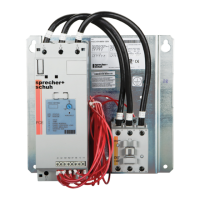Chapter 4: Troubleshooting
Chapter 4:1
e following topics are designed to assist in the troubleshooting and maintenance of the
PCEC controller. e items mentioned in this section are not intended to be all inclusive
and it is expected that they should be used as reference only.
For safety of maintenance personnel as well as others who might be exposed to electrical
hazards associated with maintenance activities, follow the local safety related work practices
(for example, the NFPA 70E, Part II in the United States). Maintenance personnel must be
trained in the safety practices, procedures, and requirements that pertain to their respective
job assignments.
SHOCK HAZARD: Hazardous voltage is present in the motor
circuit even when the PCEC Softstarter is off. To avoid shock
hazard, disconnect main power before working on the controller,
motor, and control devices such as Start-Stop push buttons.
Procedures that require parts of the equipment to be energized
during troubleshooting, testing, etc., must be performed by properly
qualified personnel, using appropriate local safety work practices and
precautionary measures.
ATTENTION: Disconnect the controller from the motor before
measuring insulation resistance (IR) of the motor windings. Voltages
used for insulation resistance testing can cause SCR failure. Do
not make any measurements on the controller with an IR tester
(megger).
Note: e time it takes for the motor to come up to speed may be
more or less than the time programmed, depending on the frictional and inertial
characteristics of the connected load.
Introduction

